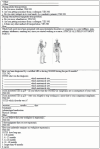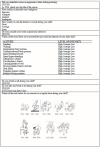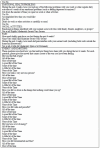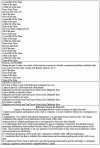Work-Related Musculoskeletal Disorders and Quality of Life in Nursing Personnel Across Northwestern Greece
- PMID: 40662007
- PMCID: PMC12259272
- DOI: 10.7759/cureus.86022
Work-Related Musculoskeletal Disorders and Quality of Life in Nursing Personnel Across Northwestern Greece
Abstract
Introduction: Work-related musculoskeletal disorders (WrMSDs) among nursing personnel have been recognized as one of the most frequent musculoskeletal injuries. The aim of the present study was to estimate the incidence of WrMSDs in a sample of nursing personnel, identify predictors of WrMSDs, and examine their effects on quality of life (QoL).
Methodology: A cross-sectional design was adopted, and participants were full-time nursing personnel at five hospitals in northwestern Greece. Data included demographics, the RAND Short Form health survey (RAND SF-36) to measure the physical (Physical Component Score, PCS) and mental (Mental Component Score, MCS) components of QoL, and the Nordic Musculoskeletal Questionnaire (NMQ) to assess WrMSDs. Data were analyzed descriptively to summarize main outcome measures, and linear models were used to estimate the effect of WrMSDs on QoL.
Results: A total of 402 participants (n = 350 females) were included. WrMSDs were prevalent in 49.5% of participants (n = 199), with the lumbar spine being the most frequently affected site (56%). WrMSDs were most strongly associated with moving patients (p < 0.001), lifting or carrying objects from the ground (p < 0.001), and the degree or intensity of heavy object lifting (p = 0.002). Nursing personnel with a WrMSD diagnosis had an average PCS score that was 5.7 points lower (95% CI: -7.4 to -4.1; p < 0.001) than those without a WrMSD diagnosis. Participants with 20-24 and >25 years of working experience had PCS scores 5.9 (95% CI: -9.1 to -2.6; p < 0.001) and 6.6 (95% CI: -9.7 to -3.5; p < 0.001) points lower, respectively, than those with <5 years of experience. Nurses and nursing supervisors/assistant supervisors had PCS scores 3.1 (95% CI: 1.3 to 4.9; p < 0.001) and 4.1 (95% CI: 0.9 to 7.3; p < 0.001) points higher, respectively, than nursing assistants. Participants with a 20-minute break had an MCS score 4.3 points higher (95% CI: 0.4 to 8.2; p = 0.032) than those with no break. Participants from GHF hospital had MCS scores 5.8 points lower (95% CI: -9.2 to -2.3; p < 0.001) than those from the University Hospital of Ioannina (UHI).
Conclusion: Nearly half of the participants were diagnosed with WrMSDs, with the lumbar spine being the most commonly affected area. Several nursing tasks were significantly associated with the occurrence of WrMSDs. The physical component of QoL was negatively affected by the presence of WrMSDs, as well as by seniority and job position. In contrast, WrMSDs did not impact the mental component of QoL. Interventions aimed at reducing the incidence of WrMSDs may improve physical health in nursing personnel; however, improving mental well-being may require additional targeted strategies.
Keywords: healthcare professionals; musculoskeletal; nursing; quality of life; risk factors.
Copyright © 2025, Sontis et al.
Conflict of interest statement
Human subjects: Informed consent for treatment and open access publication was obtained or waived by all participants in this study. University Hospital of Ioannina Institutional Review Board issued approval 8/14-04-2021. The Institutional Review Board of the University Hospital of Ioannina approved the collection of data through the NMD and SF-12 questionnaires by registered nurse Nikolaos Sontis for research purposes. Animal subjects: All authors have confirmed that this study did not involve animal subjects or tissue. Conflicts of interest: In compliance with the ICMJE uniform disclosure form, all authors declare the following: Payment/services info: All authors have declared that no financial support was received from any organization for the submitted work. Financial relationships: All authors have declared that they have no financial relationships at present or within the previous three years with any organizations that might have an interest in the submitted work. Other relationships: All authors have declared that there are no other relationships or activities that could appear to have influenced the submitted work.
Figures







Similar articles
-
Sexual Harassment and Prevention Training.2024 Mar 29. In: StatPearls [Internet]. Treasure Island (FL): StatPearls Publishing; 2025 Jan–. 2024 Mar 29. In: StatPearls [Internet]. Treasure Island (FL): StatPearls Publishing; 2025 Jan–. PMID: 36508513 Free Books & Documents.
-
Sertindole for schizophrenia.Cochrane Database Syst Rev. 2005 Jul 20;2005(3):CD001715. doi: 10.1002/14651858.CD001715.pub2. Cochrane Database Syst Rev. 2005. PMID: 16034864 Free PMC article.
-
Tirzepatide and health-related quality of life in adults with obesity or overweight: Results from the SURMOUNT-3 phase 3 randomized trial.Diabetes Obes Metab. 2025 Aug;27(8):4268-4279. doi: 10.1111/dom.16463. Epub 2025 May 14. Diabetes Obes Metab. 2025. PMID: 40365662 Free PMC article. Clinical Trial.
-
Signs and symptoms to determine if a patient presenting in primary care or hospital outpatient settings has COVID-19.Cochrane Database Syst Rev. 2022 May 20;5(5):CD013665. doi: 10.1002/14651858.CD013665.pub3. Cochrane Database Syst Rev. 2022. PMID: 35593186 Free PMC article.
-
Are Detailed, Patient-level Social Determinant of Health Factors Associated With Physical Function and Mental Health at Presentation Among New Patients With Orthopaedic Conditions?Clin Orthop Relat Res. 2023 May 1;481(5):912-921. doi: 10.1097/CORR.0000000000002446. Epub 2022 Oct 6. Clin Orthop Relat Res. 2023. PMID: 36201422 Free PMC article.
References
-
- Work-related musculoskeletal symptoms among employees with different tasks: Ahlia university case study. Tantawy S. Physiother Quart. 2022;30:59–64.
-
- Work-related musculoskeletal disorders among nurses: systematic review. Ellapen TJ, Narsigan S. J Ergon. 2014;4:1–6.
-
- Investigating prevalence of musculoskeletal disorders among Iranian nurses: a systematic review and meta-analysis. Saberipour B, Ghanbar S I, Zarea K, Gheibizadeh M, Zahedian M. Clin Epidemiol Glob Health. 2019;7:513–518.
LinkOut - more resources
Full Text Sources
